What if your next patient diagnosis wasn’t just guided by a doctor’s intuition or experience but by a mobile app capable of processing thousands of medical records in seconds? Sounds futuristic? It’s happening now. Healthcare is standing on the brink of a transformation where health diagnostics app development is rewriting the rules of patient care.
As a clinical executive or healthtech founder, you’re probably already wondering—how do we build something that doesn’t just meet the moment but shapes the future?
That’s exactly what we’ll unpack here.
Key Takeaways:
- The foundation of successful medical diagnostic application development lies in integrating AI-driven features like real-time symptom analysis and machine learning for continuous improvement, ensuring enhanced patient outcomes and operational efficiency.
- To develop a medical diagnostic app, prioritize user-friendly design, seamless integration with EHR systems, and compliance with HIPAA standards, creating a reliable and scalable tool for healthcare providers and patients alike.
- Balancing cost and quality in medical app development is critical. By focusing on essential features, regulatory compliance, and scalable design, you can reduce expenses while ensuring functionality. Leveraging expert development teams and proven tools accelerates timelines, making it easier to create a medical diagnostics mobile app without sacrificing innovation.
Table of Contents:
- Why Develop a Medical Diagnosis App?
- The Role of Mobile Apps in Disease Diagnostics
- Key Features of Medical Diagnosis Applications
- Steps to Build a Health Diagnostics App
- Privacy and Security Standards in Medical Diagnostics Mobile Apps
- How Topflight Can Help You Create a Medical Diagnostics Mobile App
Why Develop a Medical Diagnosis App?
Navigating the healthcare landscape today is anything but straightforward. Healthtech executives face mounting pressure to
- tackle staff burnout
- streamline operations
- meet the rising expectations of patients
Mobile diagnostic apps are stepping up as vital tools in this arena, offering practical solutions and innovative possibilities. Many of these innovations, like conversational AI in healthcare, are redefining how providers interact with patients, making diagnostics more accessible and efficient.
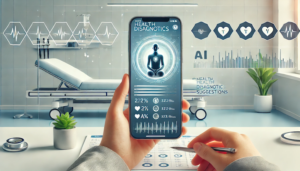
At Topflight, we understand the importance of developing a medical diagnostic app that not only meets current demands but anticipates future trends.
Mobile diagnostics have emerged as a promising solution to some of healthcare’s most pressing challenges. These apps serve as health diagnosis assistants, efficiently integrating with existing healthcare systems. By harnessing the power of artificial intelligence, they provide real-time insights that are transforming patient care. These tools are designed to be user-friendly, ensuring that both healthcare providers and patients can easily adopt them.
Medical diagnostic application development is about more than just creating software; it’s about revolutionizing the healthcare experience. From reducing operational inefficiencies to enhancing patient outcomes, these apps are becoming indispensable in our pursuit of better healthcare solutions.
The Role of Mobile Apps in Disease Diagnostics
Mobile apps are reshaping the landscape of disease diagnostics, offering a fresh approach to tackling age-old challenges in the healthcare industry. With the advent of mobile apps in disease diagnostics, we are also seeing their synergy with gen AI in healthcare, where algorithms can analyze symptoms and medical history in real time, delivering insights that elevate patient outcomes.
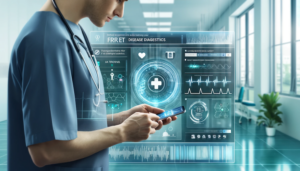
Early Detection and Real-Time Insights
A standout benefit of mobile diagnostics apps is their ability to facilitate early detection. By providing real-time insights, these apps empower healthcare professionals to identify potential health issues sooner. This proactive approach can make a significant difference in treatment plans, offering patients a better chance at positive outcomes.
Streamlined Doctor-Patient Interactions
The integration of mobile apps is also streamlining interactions between doctors and patients. With user-friendly interfaces, these apps serve as health diagnosis assistants, allowing for smoother communication and efficient management of medical data. Patients can easily share their symptoms and health records with their doctors, leading to more accurate and timely diagnoses.
Enhancing Patient Care
Ultimately, the goal is to enhance patient care. Mobile apps simplify the process of monitoring patient health, making it easier for healthcare providers to offer personalized treatment plans. By keeping the patient at the center, these apps ensure that care is both comprehensive and tailored to individual needs.
Related: A Complete Guide to Improving Patient Engagement
Practical Benefits for the Healthcare Sector
For the healthcare sector as a whole, mobile apps in disease diagnostics offer practical benefits. They help reduce the burden on healthcare systems by facilitating self-monitoring and reducing unnecessary visits. This efficiency not only saves time and resources but also helps healthcare providers focus on delivering higher-quality care where it’s needed most.
The shift towards mobile diagnostics is more than a trend; it’s a necessary evolution in improving healthcare delivery. By leveraging these tools effectively, we’re not just keeping up with technological advancements; we’re setting new standards in patient care.
Key Features of Medical Diagnosis Applications
When it comes to medical diagnosis applications, their effectiveness hinges on several key features designed to enhance both functionality and user experience. These elements not only ensure accurate diagnostics but also facilitate seamless integration into existing healthcare frameworks.
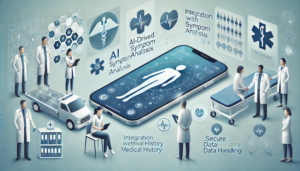
AI-Driven Symptom Analysis
At the heart of advanced medical diagnosis applications is AI-driven symptom analysis. By leveraging artificial intelligence, these apps can efficiently process vast amounts of medical data, identifying patterns and correlations that might elude human analysis. This capability is crucial for offering precise diagnostics and personalized treatment options, ultimately improving patient outcomes.
- Processes large volumes of medical data quickly and accurately
- Identifies patterns that support precise diagnostics
- Provides personalized treatment options
Integration with Medical History
Seamless integration with patients’ medical history and medical large language models further supports healthcare providers by providing detailed, context-aware recommendations during diagnostics.
By connecting with existing healthcare databases, these applications can access comprehensive medical records, providing a more holistic view of a patient’s health. This integration supports healthcare providers in making informed decisions and enhances the continuity of care, ensuring all treatments are in line with past medical events and current conditions.
- Accesses comprehensive medical records for informed decision-making
- Enhances continuity of care by aligning treatments with past medical events
User-Friendly Interfaces
The importance of user-friendly interfaces cannot be overstated. For both healthcare providers and patients, an intuitive design makes interaction with the application straightforward and efficient. Easy navigation and clear presentation of information reduce user frustration and encourage regular use, which is crucial for ongoing health monitoring and management.
- Simplifies navigation for both providers and patients
- Encourages regular use through clear information presentation
HIPAA-Compliant Data Security
Data security is non-negotiable, especially in the healthcare industry. Medical diagnosis applications must adhere to HIPAA compliance standards to protect sensitive patient information. Robust encryption protocols and secure data storage ensure that all medical data is safeguarded against unauthorized access, thus maintaining patient trust and meeting regulatory requirements.
Related: HIPAA Compliant App Development Guide
Machine Learning for Continuous Improvement
Machine learning is a powerful tool that enables these applications to learn and adapt over time. By analyzing new data inputs, the app can refine its diagnostic algorithms, improving accuracy and efficiency with each use. This continuous improvement process not only keeps the application relevant but also ensures that AI drive remains a core component of its evolving capabilities, empowering healthcare providers to deliver precise and reliable care.
Practical Integration for Healthcare Providers
Finally, practical integration with healthcare providers’ workflows during medical diagnosis app development ensures that these applications can be seamlessly incorporated into daily medical practices.
This includes compatibility with hospital systems and ease of use across various platforms, allowing healthcare professionals to focus on what they do best—providing care.
Steps to Build a Health Diagnostics App
Creating a successful health diagnostics app requires a meticulous approach. Here’s a step-by-step guide to help you build a health diagnostics app that stands out in the crowded marketplace.

Step 1: Ideation and Planning
The first step in health diagnostics app development is ideation. Here, you conceptualize your app’s core functionalities and unique selling propositions. It’s essential to:
- Identify the target audience, including patients, doctors, and hospitals.
- Define the app’s primary objectives, such as improving patient care and streamlining diagnostics.
- Research competitors to find gaps your app can fill.
Many healthcare organizations rely on specialized healthcare app development services to ensure their apps meet industry standards while addressing unique user needs like compliance, scalability, and seamless integration.
Step 2: UX/UI Design
An intuitive user experience (UX) and a sleek user interface (UI) are vital for engagement. Focus on:
- Designing a user-friendly interface that simplifies navigation.
- Ensuring accessibility across various devices to reach a broader audience.
- Incorporating feedback loops to refine the design based on user insights.
Step 3: Feature Prioritization
Not all features are created equal. Prioritize those that will have the highest impact:
- Essential diagnostics tools powered by AI for symptom analysis.
- Integration capabilities with existing medical records for seamless data access.
- Features that support appointments, treatment plans, and doctor-patient communication.
Step 4: Integration with Hospital Systems
Integration is crucial for creating a seamless experience:
- Ensure compatibility with hospital information systems to facilitate data exchange.
- Develop APIs that allow easy integration with existing healthcare technology.
- Focus on secure data handling to comply with healthcare regulations.
Ensuring compatibility with hospital systems is critical, as it enables streamlined workflows and supports broader clinical workflow automation solutions, which reduce administrative burdens on staff.
Step 5: Rigorous Testing
Testing is an ongoing process that ensures the app’s reliability and performance:
- Conduct usability testing with real users to gather actionable feedback.
- Perform security testing to identify vulnerabilities in data protection.
- Run performance tests to ensure the app handles high loads efficiently.
Step 6: Deployment and Launch
Once development and testing are complete, it’s time to launch:
- Deploy the app on various platforms, including iOS and Android, to reach a broad user base.
- Implement a feedback mechanism to gather user responses and improve the app continuously.
- Plan regular updates to fix bugs, enhance features, and incorporate new technologies.
These steps lay the foundation for developing a robust health diagnostics app. By focusing on each phase with diligence, you can create a tool that not only meets the needs of users but also elevates the standards of patient care.
Privacy and Security Standards in Medical Diagnostics Mobile Apps
When it comes to medical diagnostics mobile application development, ensuring the privacy and security of patient data is paramount. Let’s break down the key standards that your app must adhere to, to maintain trust and compliance.
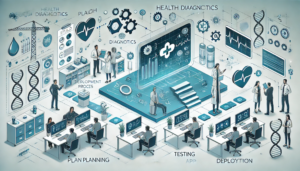
Data Privacy Regulations
Two major data privacy regulations to be aware of are HIPAA and GDPR:
- HIPAA: This U.S. regulation mandates the protection of patient information. Compliance involves implementing administrative, physical, and technical safeguards to ensure confidentiality and integrity.
- GDPR: Applicable to the EU, GDPR requires robust data protection measures and gives individuals more control over their personal data. Critical if your app operates internationally.
Data security is non-negotiable, especially when telehealth EHR integration is required or when apps must interact with other sensitive systems dependent on PHI.
Encryption Standards
Encryption is a fundamental aspect of safeguarding data:
- Data at Rest and in Transit: Use strong encryption protocols to protect data both when it is stored and when it is being transferred. AES (Advanced Encryption Standard) is widely recognized for its strength and efficiency.
- Secure Sockets Layer (SSL)/Transport Layer Security (TLS): Ensure all data exchanges between the app and servers are encrypted with SSL/TLS to prevent interception by unauthorized parties.
These encryption measures bolster your app’s defenses against potential breaches and unauthorized access.
Secure Integration Protocols
Integrating with other systems securely is a must:
- APIs and Data Exchange: Use secure APIs to facilitate data exchange with hospital systems and other healthcare applications. Ensure that these APIs are built following best practices for authentication and authorization.
- Regular Security Audits: Conduct frequent audits to identify vulnerabilities in your integration protocols. This proactive approach helps in maintaining a robust security posture.
By focusing on these protocols, you ensure that your app can seamlessly integrate into the broader healthcare ecosystem without compromising security.
Maintaining rigorous privacy and security standards is not just about compliance; it’s about building trust with users. By adhering to these guidelines, we can develop medical diagnostics mobile applications that protect sensitive data and uphold the highest levels of confidentiality.
How Topflight Can Help You Create a Medical Diagnostics Mobile App
When it comes to creating a medical diagnostics mobile app, choosing the right development partner can make or break your project. At Topflight, we pride ourselves on blending cutting-edge technology with deep healthcare expertise to deliver results that truly matter.
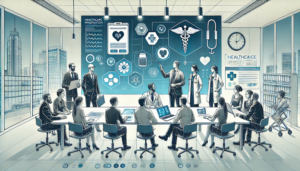
Expertise in Healthcare App Development
Building a medical diagnostics app isn’t like developing any other mobile application. It requires a nuanced understanding of healthcare workflows, patient needs, and industry regulations. Over the years, Topflight has become a trusted partner for healthcare organizations because we understand these complexities inside and out.
From ideation to launch, our team specializes in healthcare app development, ensuring every solution is tailored to meet the specific needs of providers and patients alike.
Our team works closely with you to ensure a thorough, methodical approach to:
- Custom App Design: We create intuitive, user-friendly interfaces that cater to both healthcare providers and patients.
- Server-side Architecture: Designing reliable backends that scale effortlessly as your app usage grows.
- Integration with EHR/EMR Systems: Seamlessly connecting your app with existing hospital systems like Epic or Cerner to streamline workflows.
Whether you’re looking for an MVP to test the waters or a fully-featured diagnostics platform, we’ve got you covered.
Mastery of AI and Machine Learning Frameworks
One of Topflight’s standout capabilities is creating apps that leverage cutting-edge AI frameworks to deliver actionable insights and real-time outcomes. Our work with AI-driven solutions speaks for itself:
AllHeartz Computer Vision RTM App: By incorporating computer vision technology, we helped create this remote telemonitoring app. AI-powered algorithms evaluate real-time patient images to detect health events, empowering providers with fast, actionable information.
At Topflight, we don’t just apply AI for the sake of it; we focus on solutions that tangibly impact patient outcomes and operational efficiencies.
HIPAA Compliance First, Always
Healthcare app development comes with a long list of compliance requirements—and for good reason. Any misstep can expose you to serious legal and reputational risks. At Topflight, compliance isn’t an afterthought; it’s baked into our processes.
Why We’re the Right Partner for Healthcare Transformation
At Topflight, we believe that developing a medical diagnostics app is more than a technical endeavor—it’s an opportunity to redefine patient care. With every project, we bring a holistic mindset that balances technical brilliance with user empathy and operational practicality. Our collaborative approach ensures you’re involved in every major decision, from ideation to launch.
Here’s what sets us apart:
- Cross-Functional Teams: From data scientists to UX specialists, we assemble the right people for the job.
- Agile Development: We work iteratively, keeping you in the loop every step of the way for feedback and adjustments.
- End-to-End Support: Post-launch, we offer ongoing maintenance, updates, and security audits to keep your app at the top of its game.
Related: Agile App Development Guide
Creating a medical diagnostics mobile app is no small feat, but with the right partner, it’s an opportunity to lead in healthcare innovation. Together, we can build solutions that don’t just check boxes but drive meaningful, measurable change.
Frequently Asked Questions
How can a health diagnostics app integrate with wearable devices?
By using APIs provided by wearable manufacturers, your app can collect and analyze health data in real time, seamlessly syncing with devices.
What technologies are commonly used in diagnostics app development?
Technologies include AI/ML algorithms, secure cloud platforms, EHR integrations, and tools for data analytics and encryption.
How long does it take to develop a health diagnostics app?
Development typically takes 6-12 months, depending on complexity, features, and compliance requirements.
How much does it cost to create a medical diagnostics mobile app?
Costs range from $100,000 to $500,000+, based on app features, integrations, and regulatory compliance needs. At Topflight, we have tools to create an MVP on a slimmer budget.